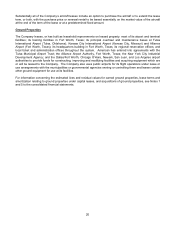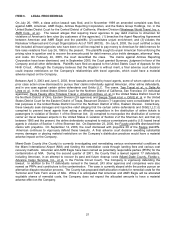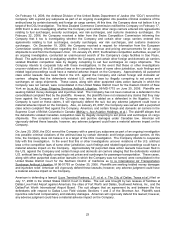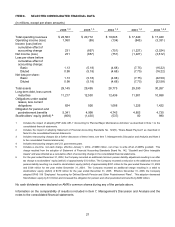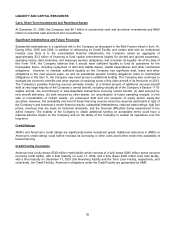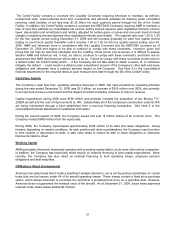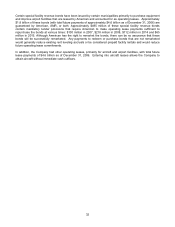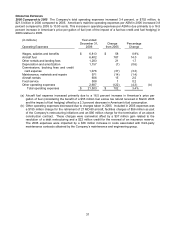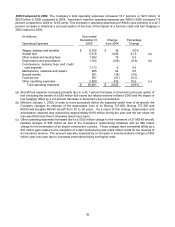American Airlines 2006 Annual Report Download - page 32
Download and view the complete annual report
Please find page 32 of the 2006 American Airlines annual report below. You can navigate through the pages in the report by either clicking on the pages listed below, or by using the keyword search tool below to find specific information within the annual report.
28
ITEM 7. MANAGEMENT'S DISCUSSION AND ANALYSIS OF
FINANCIAL CONDITION AND RESULTS OF OPERATIONS
Forward-Looking Information
The discussions under Business, Risk Factors, Properties and Legal Proceedings and the following discussions
under Management's Discussion and Analysis of Financial Condition and Results of Operations and Quantitative
and Qualitative Disclosures about Market Risk contain various forward-looking statements within the meaning of
Section 27A of the Securities Act of 1933, as amended, and Section 21E of the Securities Exchange Act of 1934,
as amended, which represent the Company's expectations or beliefs concerning future events. When used in this
document and in documents incorporated herein by reference, the words "expects," "plans," "anticipates,"
“indicates,” “believes,” “forecast,” “guidance,” “outlook,” “may,” “will,” “should,” and similar expressions are
intended to identify forward-looking statements. Forward-looking statements include, without limitation, the
Company’s expectations concerning operations and financial conditions, including changes in capacity, revenues,
and costs, future financing plans and needs, overall economic conditions, plans and objectives for future
operations, and the impact on the Company of its results of operations in recent years and the sufficiency of its
financial resources to absorb that impact. Other forward-looking statements include statements which do not
relate solely to historical facts, such as, without limitation, statements which discuss the possible future effects of
current known trends or uncertainties, or which indicate that the future effects of known trends or uncertainties
cannot be predicted, guaranteed or assured. All forward-looking statements in this report are based upon
information available to the Company on the date of this report. The Company undertakes no obligation to
publicly update or revise any forward-looking statement, whether as a result of new information, future events, or
otherwise. The Risk Factors listed in Item 1A, in addition to other possible factors not listed, could cause the
Company's actual results to differ materially from historical results and from those expressed in forward-looking
statements.
Overview
The Company recorded net earnings of $231 million in 2006 compared to a net loss of $857 million in 2005. In
addition, the Company’s unrestricted cash and short-term investments balance increased $901 million, from $3.8
billion to $4.7 billion. The Company’s 2006 results reflected an improvement in revenues somewhat offset by fuel
prices and certain other costs that were higher in 2006 compared to 2005. While the Company recorded positive
earnings in 2006, AMR incurred total losses of more than $8 billion in the five years prior to 2006 and remains
heavily indebted.
The Company’s 2006 earnings were due in part to the Company’s success in implementing fare increases to
partially offset higher fuel prices. In 2006, mainline passenger load factor increased 1.5 points year-over-year to
80.1 percent and mainline passenger revenue yield increased 6.7 percent year-over-year. However, passenger
revenue yield remains low by historical standards. The Company believes this is the result of excess industry
capacity and its reduced pricing power resulting from greater cost sensitivity on the part of travelers (especially
business travelers), increased competition from LCC’s, the use of the internet, and other factors. The Company
believes its reduced pricing power could persist indefinitely.
Offsetting these fare increases, the Company’s 2006 fuel expense increased $787 million compared to 2005
despite a decrease in mainline capacity of more than one percent. In 2006, the price of a gallon of jet fuel was
129.7 percent higher than in 2003 and the Company’s fuel expense was $3.6 billion higher in 2006 than in 2003
on a mainline capacity increase of approximately 5.0 percent.
The Company’s 2006 earnings reflect the continuing joint efforts between the Company and its employees to
identify and implement initiatives designed to increase efficiencies and revenues and reduce costs under the
Turnaround Plan. The Turnaround Plan is the Company’s strategic framework for returning to sustained
profitability and has four tenets: (i) lower costs to compete, (ii) fly smart – give customers what they value, (iii) pull
together, win together and (iv) build a financial foundation.




